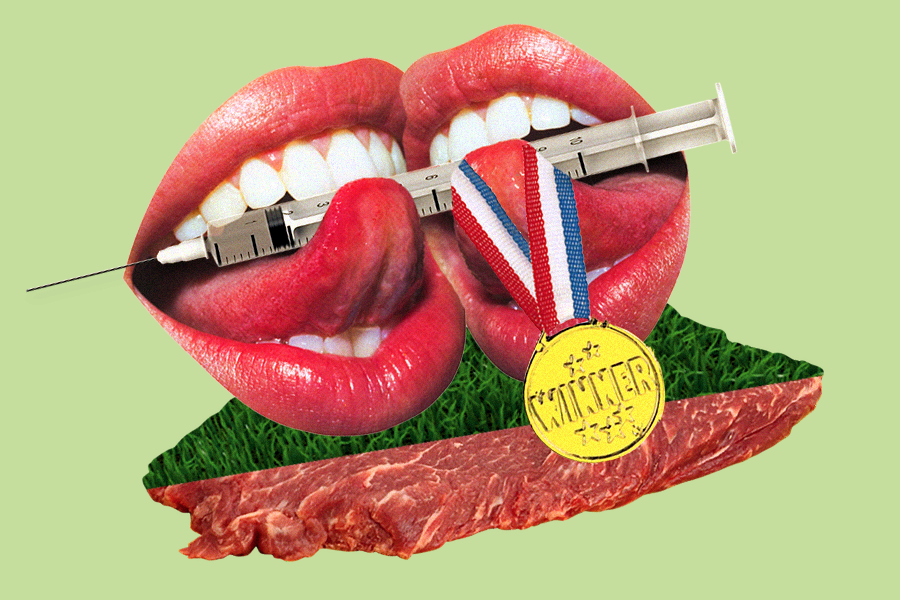Golden Boy Promotions announced on Monday that Mexican boxer, Saul “Canelo” Álvarez, tested positive for trace levels of the performance-enhancing drug clenbuterol (which has fat-burning properties used by athletes attempting to quickly drop weight). They also—as par for the course—released a laughable attempt to discredit the results: Alvarez, they say, ate meat contaminated with the drug.
“As part of the voluntary testing programme that Canelo Álvarez insisted on ahead of his 5 May fight, one of his results came back positive for trace levels of clenbuterol, consistent with meat contamination that has impacted dozens of athletes in Mexico over the last years.”
But as it turns out, blaming tainted meat isn’t as ludicrous as it seems. “These values are all within the range of what is expected from meat contamination,” Daniel Eichner, director of the World Anti-Doping Agency-accredited laboratory that conducted the test, wrote on Monday. WADA also issued a warning for athletes in 2011 to “exercise extreme caution” when consuming meat in China or Mexico, noting that both countries “have a serious problem with meat contaminated with the prohibited substance clenbuterol.”
“I am an athlete who respects the sport, and this surprises me and bothers me because it had never happened to me,” Álvarez added to the Golden Boy statement. “I will submit to all the tests that require me to clarify this embarrassing situation, and I trust that at the end, the truth will prevail.”
So, who knows? Maybe the excuse is legit.
One thing’s for sure: This certainly isn’t the first time an athlete has put forth seemingly outlandish evidence to reject a positive drug test. For example:
- Gil Roberts, Olympic sprinter: Last year, Roberts tested positive for probenecid, which is used to disguise various banned substances (like steroids). He blamed the results on frequent and passionate kissing with his girlfriend, who had been prescribed the drug Moxylong, which contains trace amounts of probenecid.
- Guillermo Mota, now-former MLB relief pitcher: In 2012, Mota tested positive for clenbuterol, claiming he took children’s cough syrup, which contains trace amounts of the drug.
- Tyler Hamilton, Olympic cyclist: In 2005, Hamilton was accused of blood doping, intravenously adding red blood cells to boost his oxygen-carrying capacity. His defense argued that the small amount of different blood found mixed in with his own came from an absorbed unborn twin in utero.
- Dennis Mitchell, Olympic sprinter: In 1998, Mitchell tested positive for high testosterone, defending himself by attributing the results to having sex with his wife four separate times and consuming five beers. “It was her birthday,” he said. “The lady deserved a treat.”
- Petr Korda, pro tennis player: In 1998, Korda tested positive for nandrolone, an anabolic steroid that allows for faster recovery. His rebuttal was that he had simply eaten too many nandrolone-fattened calves (i.e., factory farmed veal).
While each one of these excuses appears desperate to say the least, deciding whether they may be accurate—and serving justice based on that decision—isn’t a cut-and-dried process.
“The anti-doping system is designed and resourced to develop drug tests that detect doping in athletes,” says Oliver Catlin, president of the Banned Substances Control Group (and son of renowned anti-doping guru Don Catlin). “We’re attentive when we develop those methods to ensure that they don’t detect false positives, but how far can we go as an industry—as anti-doping—to exhaust all the possible scenarios that could be presented in that regard?” For example, the resources necessary to discern whether trace amounts of clenbuterol found in meat are truly enough to cause positive tests may not be currently available.
“I could invent a reason for many positive tests,” Catlin continues. “Fifteen years ago, when I started in this industry, I thought I was getting involved in something black and white. I’ve since learned that’s far from the case.”
For many athletes, the science behind this testing can make or break their career. But the anti-doping industry constantly faces new challenges, since there’s no end to the number of ways one can be exposed to a banned substance (e.g., by simply eating a steak in Mexico).
“It’s even more difficult when you’re involved with these cases, because then you get to see the passion these athletes feel toward the sports they love,” Catlin emphasizes. “At the end of the day, that’s what makes us passionate. We’re not sitting here getting off on busting athletes. Our industry is about finding the truth in these situations, and protecting clean athletes (and the sports) in the process. That has to be done well enough so that clean athletes don’t get hurt. That also has to be done well enough so that athletes who dope can’t get off with an invented excuse. Therein lies the challenge that we always have.”
Whether there will ever be a solution to this problem remains uncertain. So for now, we’ll have to watch athletes continue to come up with imaginative excuses for testing positive.
But hey, at least they’re entertaining.

